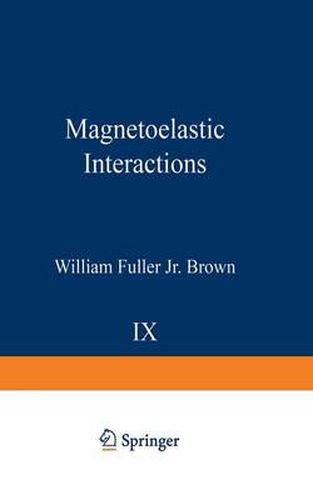Readings Newsletter
Become a Readings Member to make your shopping experience even easier.
Sign in or sign up for free!
You’re not far away from qualifying for FREE standard shipping within Australia
You’ve qualified for FREE standard shipping within Australia
The cart is loading…






This title is printed to order. This book may have been self-published. If so, we cannot guarantee the quality of the content. In the main most books will have gone through the editing process however some may not. We therefore suggest that you be aware of this before ordering this book. If in doubt check either the author or publisher’s details as we are unable to accept any returns unless they are faulty. Please contact us if you have any questions.
The modern theory of ferromagnetic magnetization processes has from the beginning recognized the importance of magnetoelastic inter actions. Most of the magnetoelastic calculations, however, have been basecl on the theory developed by R. BECKER and others in the early 1930’s. That theory has several defects; how to remedy them is the subject of this monograph. I first became aware of the shortcomings of the traditional theory thru a critical study of electric and magnetic forces, which I undcrtook as a member of the COULOMB’S Law Committee of the American Asso ciation of Physics Teachers. My conclusions were published in 1951 in the American 10Z/rnal of Physics; an application of them to a problem in magnetostriction was published in 1953 in Reviews oflvlodern Physics. With the development, in 1956, of the nucleation field theory of micromagnetics, the need for a systematic and self-consistent theory of magnetoelastic interactions became more pressing. The traditional theory predicted that the nucleation field should differ negligibly from that of a rigid body; but my 1953 magnetostriction calculation suggested that terms omitted in that theory might be important. In the academic year 1963/64, 1 was finally able - thanks to a sabbatical furlough - to find the time needed for systematic development of a basic theory of magnetoelastic interactions in a ferromagnet.
$9.00 standard shipping within Australia
FREE standard shipping within Australia for orders over $100.00
Express & International shipping calculated at checkout
This title is printed to order. This book may have been self-published. If so, we cannot guarantee the quality of the content. In the main most books will have gone through the editing process however some may not. We therefore suggest that you be aware of this before ordering this book. If in doubt check either the author or publisher’s details as we are unable to accept any returns unless they are faulty. Please contact us if you have any questions.
The modern theory of ferromagnetic magnetization processes has from the beginning recognized the importance of magnetoelastic inter actions. Most of the magnetoelastic calculations, however, have been basecl on the theory developed by R. BECKER and others in the early 1930’s. That theory has several defects; how to remedy them is the subject of this monograph. I first became aware of the shortcomings of the traditional theory thru a critical study of electric and magnetic forces, which I undcrtook as a member of the COULOMB’S Law Committee of the American Asso ciation of Physics Teachers. My conclusions were published in 1951 in the American 10Z/rnal of Physics; an application of them to a problem in magnetostriction was published in 1953 in Reviews oflvlodern Physics. With the development, in 1956, of the nucleation field theory of micromagnetics, the need for a systematic and self-consistent theory of magnetoelastic interactions became more pressing. The traditional theory predicted that the nucleation field should differ negligibly from that of a rigid body; but my 1953 magnetostriction calculation suggested that terms omitted in that theory might be important. In the academic year 1963/64, 1 was finally able - thanks to a sabbatical furlough - to find the time needed for systematic development of a basic theory of magnetoelastic interactions in a ferromagnet.